SAN DIEGO — Cameras were allowed a closer look at a so-called game of cat and mouse between federal authorities and Mexican cartels.
We have brought you many stories about the activity along our border. However, it's a very different situation at sea.
The agents who usually patrol our waters are now helping their peers as the maritime unit was put on pause - but still, several agencies are stepping in to stop smugglers.
"There are people who get lucky, and it happens every day," Daniel Houle said, Deputy Enforcement Chief for the U.S. Coast Guard.
Most recently, a small panga washed up on the beach in Carlsbad. Seventeen life jackets were found on board. Hours later, a fishing boat full of people arrived on South Mission. Five people were apprehended. The rest are unaccounted for.
"We've seen a 771% increase in human smuggling activity. We are only getting about 30% of what we know is out there," Dan Wishnoff said, an Executive Officer with the U.S. Coast Guard.
CBS 8 was given a first-hand look at the multi-layered approach to stopping human smuggling. From Customs and Border Protection officers at the port to cameras, sensors, and Border Patrol boots on the ground - to the Navy and Coast Guard patrolling the air and sea, sometimes that's not enough.
"Safety of life is not a priority for them; smugglers are only focused on making money—day, night. Good weather, bad weather," Houle said.
When smuggling is suspected, these agencies are trained to alert the Joint Harbor Operations Center. It serves as a 24/7 dispatch for all incidents on the water.
"We're so stretched thin. There might be multiple incidents at night, and we must handle 20 people alone," Wishnoff added.
In Fiscal Year 2019, 660 migrants were apprehended off our coast. Last year, more than 2,500 apprehensions were made by local Border Patrol out at sea.
"Most of these people are good people and want that better life. But we see a criminal element trying to come with them. Mixed in with these family units. We must do our due diligence and ensure we know who's coming into the country," Wishnoff said.
The boats are often gutted to make space for as many migrants as possible. That extra weight is one tell-tale sign to the trained eye.
"We learn their techniques -- are there fishing poles that aren't being used? Things like that, are these boats riding low in the water? If you have 20 on board, it sits lower. So we make those stops, check out those boats, and identify if human smuggling is happening," Wishnoff said.
Border Patrol Agents say some people are eager to begin the asylum-seeking process. Others run and have a get-away car or a stash house waiting.
"We do get swimmers, jet skis, and boats coming right up, so there is always someone here in this location.
Smugglers know. They watch us as much as we watch them, Agent Eric Lavergne said, who is a Special Operations Supervisor for the Border Patrol.
As for those who get caught, the next step all depends on their record. Everyone is processed and fingerprinted, but some are deported within the hour. Others are taken to a shelter, given a court date, possibly a few years from now, and released into our community.
WATCH RELATED: U.S. Border Patrol: 200 asylum seekers dropped off at San Diego transit centers

